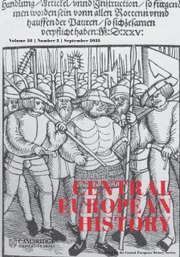Leigh T. I. Penman's book offers a fascinating biographical portrait of Ludwig Friedrich Gifftheil (1595–1661) and, in the process, provides new insights and perspectives on the “murky underworld of seventeenth-century prophecy and religious dissent” (4). The German barber-surgeon turned prophet was an iridescent and contradictory figure, who came to reject the “apocalyptic foment of Lutheran confessional culture … in favour of a heterodox spiritualistic religiosity.” The ideas of this “new prophet,” who endeavored “to challenge, not strengthen, the territorial churches,” are more akin to those within the European theosophical movement (5).
Penman pays close attention to Gifftheil's sociological setting (his Sitz im Leben) and identifies the man's early life experiences as the most formative influence on his thought. According to Penman, the prophet must be understood not only within the religious and intellectual currents of his time (theosophy, etc.), but, significantly, also within the context of his own personal and family history. His father's disgrace and his brother's suicide left him with a sense of belonging to a family wronged, and, thus, “Gifftheil's story, at its most basic level, is that of a man's attempt to redeem his family's lost honour” (11). All later stages—from his rebirth as a divine prophet to his feverish pursuit of world peace via violent means—were rooted in these early experiences.
Penman moreover shows that the prophet's religious ideas were not outliers to the contemporary European spiritual community. Instead, Gifftheil's story and teachings were embedded in the social, cultural, intellectual, and religious milieu of his time. He drew on the religious concepts of Paracelsus, Johann Arndt, and Jacob Böhme, but connections also abounded to earlier sixteenth-century movements, such as Anabaptism, Thomas Müntzer, and the Münsterites. Instead of dismissing Gifftheil as a mad prophet, Penman highlights the prophet's many loyal followers, who found inspiration in his calls for inner renewal. Still, there resided a fundamental incongruity and idiosyncrasy in Gifftheil's teachings. On the one hand, he was driven by a deep desire for peace that, Penman claims, later became all-consuming (30); on the other, Gifftheil came to advocate violence to attain such peace and even attempted to field his own army. Although in service to ultimate world peace, his turn toward militancy became a point, on which many of his initial supporters in the theosophical movement disagreed and eventually parted ways with him. The question of warfare continued to be a contentious issue within Europe's spiritual community.
Penman further underscores that, in addition to the relatively strong following within the theosophic community, Gifftheil had remarkable access to a wide range of political leaders. The prophet was a restless man who never married and only reluctantly settled down toward the end of his life, when age and health became too great of an obstacle. Until then he repeatedly traveled to England, France, the Netherlands, and other lands within and without the Holy Roman Empire to convince rulers of his vision and to obtain support for his action plan. While the prophet's success in obtaining admittance to centers of power is striking, it must be said that Gifftheil was not really “heard.” Heads of governments quickly dismissed the prophet and what they considered his outlandish designs, such as his request for resources to finance an army under the prophet's leadership. Penman contends that Gifftheil's ability to secure access to the mighty manifests the robustness of his spiritual community and the instability of the time when a confused message of peace and war could find a hearing. The author also speculates that the perception of Gifftheil's madness or foolishness may have been the key to the corridors of power (105).
Gifftheil's paradoxical pursuit of true peace through holy war remains a mystery. He had served as a soldier and a field surgeon in the armies of the Protestant Union during the Thirty Years’ War and, thus, had close experience of war's destructive side. In lieu of any written evidence, Penman conjectures that war must have traumatized his protagonist. But why Gifftheil embraced war's role in bringing about world peace remains elusive. Here, a deeper contextualization within trends toward active apocalypticism may have been beneficial.
The author enhances Gifftheil's portrait in other important ways. Although his contemporaries repeatedly commented on the prophet's lack of formal training, Gifftheil was skilled at adapting his message to fit his audience. Penman also submits that “Gifftheil's adoption of a prophetic identity … allowed him to transcend his lowly social status” and enabled him to speak to political leaders (10). A most intriguing aspect concerns the ways in which Gifftheil “fashioned” his persona—literally. Dressed in a solemn gray coat, carrying a staff, and sporting a long beard and flowing hair, he unmistakably signaled his prophetic calling to the world.
Penman's biography does not end with the prophet's death but considers the role Gifftheil's writings played within the pietist movement and Lutheran global missions. While Gifftheil did not become a prominent stimulus, pietists and missionaries nevertheless read his books and found common ground in their goals of inner reform and spiritual rebirth.
Organized according to turning points in Gifftheil's life, the book is well written and free of jargon. Penman draws particularly on the prophet's epistolatory network, which adds valuable new information to our understanding of this colorful figure. The author also successfully situates Gifftheil in various contemporary contexts, e.g., the theosophical environment. Regarding links to earlier radical figures and movements, such contextualization is much less in evidence. Thomas Müntzer, the Kingdom of Münster, and the Mennonites are mentioned but their connections to and importance for understanding Gifftheil remain largely unexplained. Another point on which more contexts would have been helpful concerns the disillusionment among Lutheran ministers, among whom Gifftheil found many willing followers. A brief elucidation of the contemporary state of Lutheran clergy would have been useful. All the same, Penman's book is a wonderful contribution to the growing literature on prophecy and spirituality in the seventeenth century.


